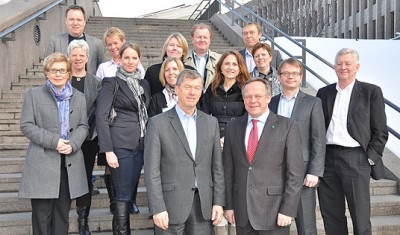Grocery store owners fight back
Norway’s grocery store owners are refusing to take the blame for the country’s high food prices and relatively poor selection of goods. A state commission delivered its long-awaited report on the highly debated issue Wednesday and, as expected, held the retailers largely responsible, but they’re fighting back.

Here's the commission that has struggled to evaluate where the power lies within Norway's grocery business. They did not examine tariff levels or farmers' prices, claiming that was not part of their mandate. Others disagree, and already have discredited the commission's findings. In front, commission head Einar Steensnæs (left) and Agriculture Minister Lars Peder Brekk. PHOTO: Landbruksdepartementet
The commission, headed by a former cabinet minister and veteran politician from the Christian Democrats party, Einar Steensnæs, concluded that Norway’s food prices are fully 51 percent higher, on average, than elsewhere in Europe. Norway, according to the commission, has the most expensive food, the fewest goods on the shelves and the least competition for customers among retailers.
Their report concluded that the four major retail chains that control 99 percent of the market in Norway have, over time, accumulated a disproportionate amount of power in establishing price levels, but Steensnæs claims his commission was not “out to get” the retail chains. Rather, Steensnæs said, his group sought out the source of power in the grocery business, “and then it was natural for us to see where the power was most concentrated.”
‘Disproportionate power’
He said the commission’s investigation has found that the four large retail organizations (NorgesGruppen, Reitangruppen, Coop Norge and ICA Norge) have acquired power throughout the so-called “value chain” at the cost of the food producers (farmers, for example) and other suppliers to the retail chains. Steensnæs said the retailers have acquired an increasing level of control by centralizing their purchasing, distribution and pricing. Some retailers also have gone into the wholesale business, taking control themselves of suppliers of fruit and vegetables, for example, or some meat.
He said the commission’s investigation has found that the four large retail organizations (NorgesGruppen, Reitangruppen, Coop Norge and ICA Norge) have acquired power throughout the so-called “value chain” at the cost of the food producers (farmers, for example) and other suppliers to the retail chains. Steensnæs said the retailers have acquired an increasing level of control by centralizing their purchasing, distribution and pricing. Some retailers also have gone into the wholesale business, taking control themselves of suppliers of fruit and vegetables, for example, or some meat.
The report was well received by the man who ordered it, Agriculture Minister Lars Peder Brekk from the farmer-friendly Center Party. As the state enters into annual subsidy negotiations with the farmers’ lobby, and with farmers marching in the streets this week to demand support for locally produced food, Brekk was clearly keen to look for other reasons for Norway’s high food prices than the farmers’ relatively high-cost- and protected operations themselves.
The retailers themselves, and quite a few analysts and professors, argue that the high prices at Norwegian grocery stores – where a dozen eggs just went up to nearly USD 8 – are a result of many factors, including Norway’s overall high cost levels, high and unique taxes (like its special and harsh taxes on products like beer, chocolate or carbonated soft drinks) and, not least, its extraordinarily high tariffs that are set to block imports and protect Norwegian agricultural products.
Commission’s controversial proposals
“It’s not the retail chains’ margins that keep prices up,” economics professor Odd Gisholt at business college BI wrote in newspaper Dagens Næringsliv (DN) earlier this week. He claimed Norway’s four large retail chains have actually contributed to keeping Norway’s food prices lower than they otherwise might have been, by refusing to pay the prices suppliers have demanded. He and others also have pointed out that grocery selection today is far better than it was as late as the early 1990s, for example, when it wasn’t even possible to buy fresh chicken or fish in most grocery stores. For that, consumers had to visit much higher-priced speciality stores.
“It’s not the retail chains’ margins that keep prices up,” economics professor Odd Gisholt at business college BI wrote in newspaper Dagens Næringsliv (DN) earlier this week. He claimed Norway’s four large retail chains have actually contributed to keeping Norway’s food prices lower than they otherwise might have been, by refusing to pay the prices suppliers have demanded. He and others also have pointed out that grocery selection today is far better than it was as late as the early 1990s, for example, when it wasn’t even possible to buy fresh chicken or fish in most grocery stores. For that, consumers had to visit much higher-priced speciality stores.
The debate is expected to continue in the months ahead, not least over the commission’s proposal to pass a new law on “good trade ethics” that would regulate negotiations between retailers and suppliers. The commission also proposes establishing an ombudsman to monitor prices and consumer complaints, toughen competition laws, regulate copy-cat goods produced by the retailers and set up a consumer grocery portal where customers could compare prices.
The retailers, predictably, oppose additional regulation and want tariff levels to be reduced, so they can import more goods, improve selection for consumers and have more options when negotiating with Norwegian producers. Selection at even a small Norwegian-owned REMA 1000 store in Denmark, for example, is far better than at a large REMA 1000 store in Norway, because it can offer fresh goods from all over Europe at moderate prices. Import tariffs prevent REMA officials from offering the same in Norway.
Views and News from Norway/Nina Berglund (News in English)

No comments:
Post a Comment